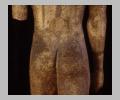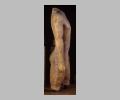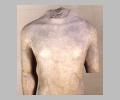| Collection: | Paris, Musée du Louvre |
| Title: | Later Kouros from Actium |
| Findspot: | Found at Actium, Sanctuary of Apollo |
| Summary: | Standing nude youth |
| Material: | Marble |
| Sculpture Type: | Free-standing statue: kouros |
| Style: | High Archaic |
| Technique: | In-the-round |
| Original or Copy: | Original |
| Date: | ca. 560 BC - ca. 550 BC |
| Dimensions: | H 0.995 m |
| Scale: | Life-size |
| Region: | Acarnania |
| Period: | High Archaic |
Subject Description:
The more stylistically advanced of the two kouroi from Actium, the torso exhibits well-modeled though simple forms. The front is delineated by a series of ridges and grooves: horizontal clavicles, a shallow but clear median line descending from the sternum to the navel and a distinctly marked arch separating the thorax from the abdomen. Four horizontal lines divide the abdomen above the navel. In the back the spine is indicated not only by a central vertical groove, but by parallel grooves on either side. The shoulder blades are distinctively marked as well, though are less noticeable since these lines abut the hair. The overall proportions are long and slender. The shoulders slope; the arms hang loosely at the sides but have been carefully separated along the torso from the arm pit to below the wrist. The hands are clenched. On the hips a soft ridge marks the iliac crest. The left leg is well advanced. The hair is massed softly over the shoulders, then gathered loosely behind with a double band of ribbon. Below the ribbon it falls neatly in a narrow spread almost to the middle of the neck. All the hair is carefully rendered in a beaded style. A bronze statuette from Argos exhibits a similar coiffure (
Like the kouroi from Sounion and the Ptoon Sanctuary in Boeotia, the Actium youths are closely linked with Apollo since they apparently come from his sanctuary. The location of the remains fit the description of Strabo (
Form & Style:
Because the Sanctuary of Apollo at Actium belongs to a territory said to have been founded by Corinth (
Buschor and Wallenstein also suggest a Corinthian origin or influence. On the other hand, long ago Deonna attributed both Actium kouroi to Naxos. In his study of the Naxian school, Pedley also argues for such an attribution.
Date Description:
Richter places the later Actium kouros late within her Tenea-Volomandra Group, dated to the second quarter of the 6th century. She compares the earlier members of the group with the François vase in particular, which places the more developed members in the decade prior to the middle of the century.
Condition: Fragmentary
Condition Description:
Preserved from neck to middle of knees. Left arm broken just above elbow; analogous break where hand meets thigh. Heavily weathered. Modern hole at back now filled with plaster.
Material Description:
Probably Island marble (Richter)
Collection History:
Found by Champoiseau, French consul to Ioannina, in 1867 together with Louvre 688. Reportedly from the Temple of Apollo at Actium, of which traces were noted when the find was made.
Sources Used:
Other Bibliography:





